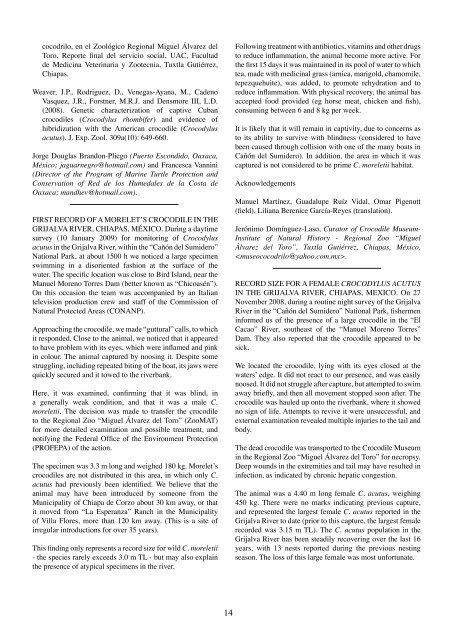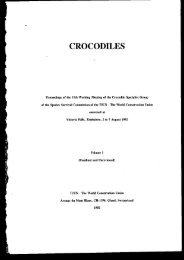CROCODILE SPECIALIST GROUP NEWSLETTER
CROCODILE SPECIALIST GROUP NEWSLETTER
CROCODILE SPECIALIST GROUP NEWSLETTER
You also want an ePaper? Increase the reach of your titles
YUMPU automatically turns print PDFs into web optimized ePapers that Google loves.
cocodrilo, en el Zoológico Regional Miguel Álvarez del<br />
Toro. Reporte final del servicio social, UAC, Facultad<br />
de Medicina Veterinaria y Zootecnia, Tuxtla Gutiérrez,<br />
Chiapas.<br />
Weaver, J.P., Rodriguez, D., Venegas-Ayana, M., Cadeno<br />
Vasquez, J.R., Forstner, M.R.J. and Densmore III, L.D.<br />
(2008). Genetic characterization of captive Cuban<br />
crocodiles (Crocodylus rhombifer) and evidence of<br />
hibridization with the American crocodile (Crocodylus<br />
acutus). J. Exp. Zool. 309a(10): 649-660.<br />
Jorge Douglas Brandon-Pliego (Puerto Escondido, Oaxaca,<br />
México; jaguarnegro@hotmail.com) and Francesca Vannini<br />
(Director of the Program of Marine Turtle Protection and<br />
Conservation of Red de los Humedales de la Costa de<br />
Oaxaca; mandhev@hotmail.com).<br />
FIRST RECORD OF A MORELET’S <strong>CROCODILE</strong> IN THE<br />
GRIJALVA RIVER, CHIAPAS, MÉXICO. During a daytime<br />
survey (10 January 2009) for monitoring of Crocodylus<br />
acutus in the Grijalva River, within the “Cañón del Sumidero”<br />
National Park, at about 1500 h we noticed a large specimen<br />
swimming in a disoriented fashion at the surface of the<br />
water. The specific location was close to Bird Island, near the<br />
Manuel Moreno Torres Dam (better known as “Chicoasén”).<br />
On this occasion the team was accompanied by an Italian<br />
television production crew and staff of the Commission of<br />
Natural Protected Areas (CONANP).<br />
Approaching the crocodile, we made “guttural” calls, to which<br />
it responded. Close to the animal, we noticed that it appeared<br />
to have problem with its eyes, which were inflamed and pink<br />
in colour. The animal captured by noosing it. Despite some<br />
struggling, including repeated biting of the boat, its jaws were<br />
quickly secured and it towed to the riverbank.<br />
Here, it was examined, confirming that it was blind, in<br />
a generally weak condition, and that it was a male C.<br />
moreletii. The decision was made to transfer the crocodile<br />
to the Regional Zoo “Miguel Álvarez del Toro” (ZooMAT)<br />
for more detailed examination and possible treatment, and<br />
notifying the Federal Office of the Environment Protection<br />
(PROFEPA) of the action.<br />
The specimen was 3.3 m long and weighed 180 kg. Morelet’s<br />
crocodiles are not distributed in this area, in which only C.<br />
acutus had previously been identified. We believe that the<br />
animal may have been introduced by someone from the<br />
Municipality of Chiapa de Corzo about 30 km away, or that<br />
it moved from “La Esperanza” Ranch in the Municipality<br />
of Villa Flores, more than 120 km away. (This is a site of<br />
irregular introductions for over 35 years).<br />
This finding only represents a record size for wild C. moreletii<br />
- the species rarely exceeds 3.0 m TL - but may also explain<br />
the presence of atypical specimens in the river.<br />
Following treatment with antibiotics, vitamins and other drugs<br />
to reduce inflammation, the animal become more active. For<br />
the first 15 days it was maintained in its pool of water to which<br />
tea, made with medicinal grass (arnica, marigold, chamomile,<br />
tepezquehuite), was added, to promote rehydration and to<br />
reduce inflammation. With physical recovery, the animal has<br />
accepted food provided (eg horse meat, chicken and fish),<br />
consuming between 6 and 8 kg per week.<br />
It is likely that it will remain in captivity, due to concerns as<br />
to its ability to survive with blindness (considered to have<br />
been caused through collision with one of the many boats in<br />
Cañón del Sumidero). In addition, the area in which it was<br />
captured is not considered to be prime C. moreletii habitat.<br />
Acknowledgements<br />
Manuel Martínez, Guadalupe Ruíz Vidal, Omar Pigenutt<br />
(field), Liliana Berenice García-Reyes (translation).<br />
Jerónimo Domínguez-Laso, Curator of Crocodile Museum-<br />
Institute of Natural History - Regional Zoo “Miguel<br />
Álvarez del Toro”, Tuxtla Gutiérrez, Chiapas, México,<br />
.<br />
RECORD SIZE FOR A FEMALE CROCODYLUS ACUTUS<br />
IN THE GRIJALVA RIVER, CHIAPAS, MEXICO. On 27<br />
November 2008, during a routine night survey of the Grijalva<br />
River in the “Cañón del Sumidero” National Park, fishermen<br />
informed us of the presence of a large crocodile in the “El<br />
Cacao” River, southeast of the “Manuel Moreno Torres”<br />
Dam. They also reported that the crocodile appeared to be<br />
sick.<br />
We located the crocodile, lying with its eyes closed at the<br />
waters’ edge. It did not react to our presence, and was easily<br />
noosed. It did not struggle after capture, but attempted to swim<br />
away briefly, and then all movement stopped soon after. The<br />
crocodile was hauled up onto the riverbank, where it showed<br />
no sign of life. Attempts to revive it were unsuccessful, and<br />
external examination revealed multiple injuries to the tail and<br />
body.<br />
The dead crocodile was transported to the Crocodile Museum<br />
in the Regional Zoo “Miguel Álvarez del Toro” for necropsy.<br />
Deep wounds in the extremities and tail may have resulted in<br />
infection, as indicated by chronic hepatic congestion.<br />
The animal was a 4.40 m long female C. acutus, weighing<br />
450 kg. There were no marks indicating previous capture,<br />
and represented the largest female C. acutus reported in the<br />
Grijalva River to date (prior to this capture, the largest female<br />
recorded was 3.15 m TL). The C. acutus population in the<br />
Grijalva River has been steadily recovering over the last 16<br />
years, with 13 nests reported during the previous nesting<br />
season. The loss of this large female was most unfortunate.<br />
14
















